When living or visiting Arizona, there are about 60 lizards you can come across. Having some understanding of the different lizards can help you identify them quickly. No more guessing what the lizard is in your yard.
Continue reading to find out more about the lizards of Arizona.
Table of Contents
Are There Poisonous Lizards In Arizona?
There is one poisonous lizard you may come across in Arizona, the Gila Monster. This lizard will generally not bite unless it is handled.
They are large lizards with short legs.
They bite using their teeth, they do not have fangs, the venom then enters through the bite.
The Gila Monster will hold onto their victim, whether it’s you, your child, or your pet, which makes them very difficult to remove.
The jaws are strong and can cause an injury, which will cause severe swelling.
Symptoms of a Gila Monster bite:
- Burning pain or throbbing in the bite area
- Bleeding
- Swelling that gets worse
- Teeth that are stuck in the wound once the lizard is removed
- Dizziness
- Nausea or vomiting
- Weakness
- Breathing problems
- Sweating
If you, a family member, or a pet has been bitten by a Gila Monster, seek urgent medical treatment.
More information about the Gila monster in Arizona here.
60 Common Arizona Lizards
Below are 60 lizards you can see in Arizona:
1. Ornate Tree Lizard

Scientific name: Urosaurus ornatus.
Common name: Ornate tree lizard.
These tree lizards grow up to 2.3 inches (5.9cm) from snout to vent.
Males have turquoise on their bellies, though their base color can be varied with nine color types being documented to date.
The ornate tree lizard populations in Arizona tend to have two types of colors. The first is an orange throat patch with blue center, while the second has a solid orange dewlap.
It has been noted that the males with orange and blue dewlaps are more aggressive and very territorial.
2. Common Side-Blotched Lizard

Scientific name: Uta stansburiana.
Common name: Common side-blotched lizard.
Common side-blotched lizards live in dry regions with three morphs that use a different method to secure a mate. The morphs compete until one morph has the final advantage.
Males can grow up to 2.4 inches (6cm) from snout to vent, with females being slightly smaller.
Some males have blue on their tails and backs with yellow or orange sides, while others have no pattern at all. Females have stripes down their backs.
Both sexes have a blotch on their sides, behind the front limbs.
Further Reading: 16 lizards with blue tails in the United States.
3. Desert Spiny Lizard

Scientific name: Sceloporus magister.
Common name: Desert spiny lizard.
Desert spiny lizards are common in Arizona.
The adults have blue patches on their dewlap and belly with green or blue on their sides and tails. Juveniles and females have dark spots on their backs and tummies. Both sexes have triangular spots of brown or yellow on their shoulders.
Adults grow up to 5.6 inches. They tend to get darker in winter to absorb more heat and lighter in summer to deflect the radiation on the sun.
These lizards can be found in the southwestern parts of Arizona.
They prefer woodlands and can be found in low valleys, tree branches, woodpiles, rock piles, and on plains.
Further Reading: 13 lizards with blue bellies in the United States.
4. Yarrow’s Spiny Lizard

Scientific name: Sceloporus jarrovii.
Common name: Mountain spiny lizard, Yarrow’s spiny lizard.
Yarrow’s spiny lizard (Sceloporus jarrovii) prefers forests and rocky areas.
They grow up to 4.1 inches (10.5cm) from snout to vent with a cross pattern on their bodies.
They range in color from green and blue to pink and copper with dark gray on the top of their heads. Males can be distinguished with their blue belly and throat.
5. Zebra-tailed Lizard
Scientific name: Callisaurus draconoides.
Common name: Zebra-tailed lizard.
The zebra-tailed lizard prefers open deserts where the soil is hard with limited vegetation and rocks.
They grow up to 4 inches (10.2cm) from snout to vent.
They are a light brown to gray color with dark gray spots which span down their backs, along with black cross bands on their tails.
They have a white underside to their tails with black crossbars, while males have black blotches on their sides, which extend the blue on their tummies.
These are very alert lizards and remain active even on the hottest of days. When threatened, they run with their tails raised over their backs, to expose their stripes. They will wage their tails to distract their predators.
6. Greater Short-horned Lizard

Scientific name: Phrynosoma hernandesi.
Common name: Greater short-horned lizards, mountain short-horned lizard.
The greater short-horned lizards are flat bodies with short spines that crown their heads. They have short legs and a snub nose, growing to around 6 inches (15cm) in total length, males are smaller than females.
These are what you would call “sit and wait” predators. They feed mostly on ants, with some grasshoppers and beetles from time to time. They are often found sitting near a nest or trail.
They are active in the evening and burrow at night to stay out of sight of any predators.
When provoked, they build blood pressure up behind their eyes, which allows them to squirt blood from the eye to attack their predator.
7. Plateau Fence Lizard

Scientific name: Sceloporus tristichus.
Common name: Plateau fence lizard.
The plateau fence lizard has spiny scales on the upper side of their bodies with varied coloration ranging from green to brown and gray with dark brown cross bands on both sides. They have a metallic blue patch on either side of their belly and throat.
Males have brighter blue patches than females.
Males are smaller than the females with average sizes around 2.9 inches (7.5cm) from snout to vent.
They prefer living in rocky areas, such as canyon walls, hillsides, and fallen tree trunks.
8. Western Whiptail
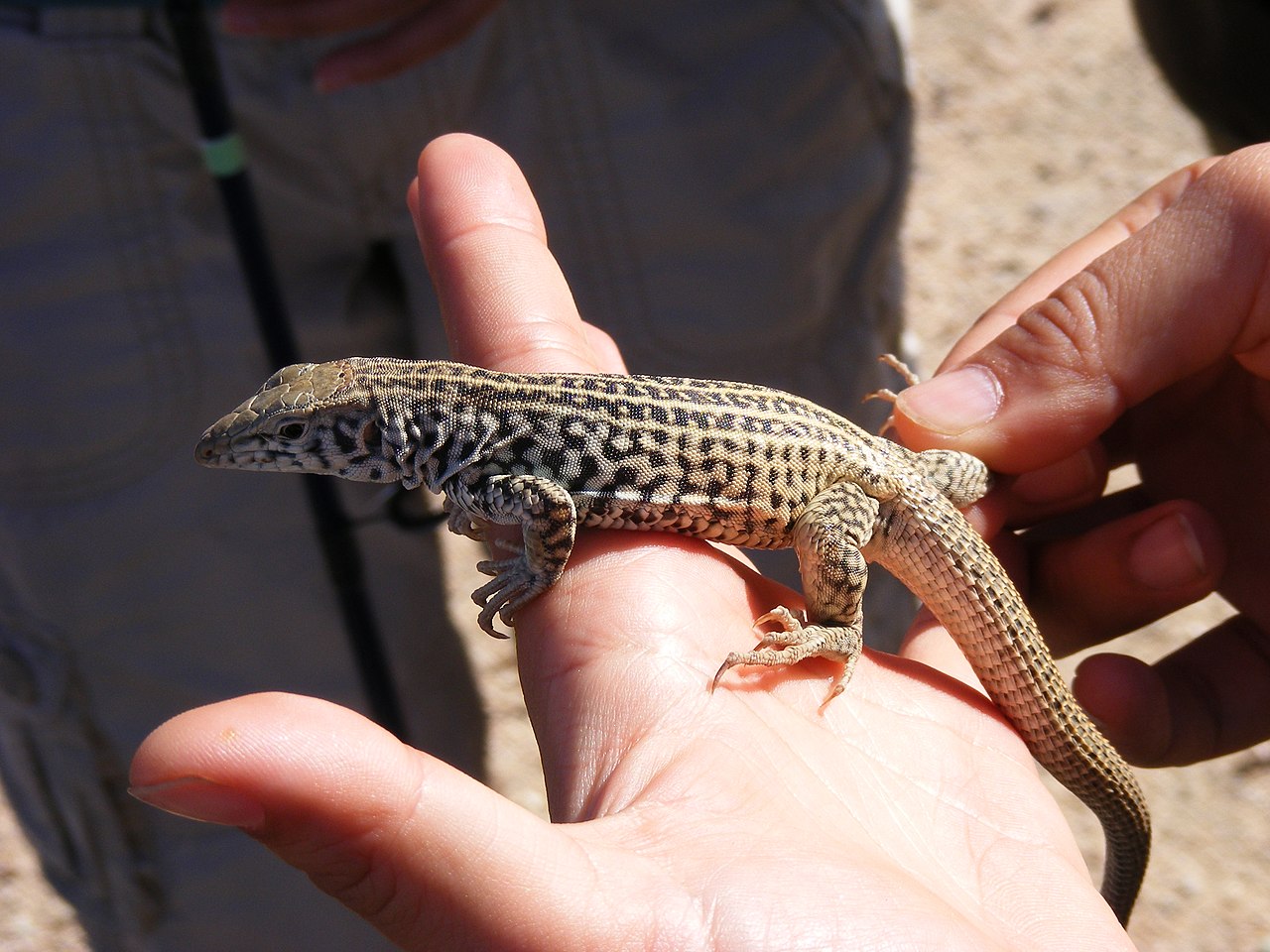
Scientific name: Aspidoscelis tigris.
Common name: Western whiptail.
This lizard is common in the southwestern United States and northern Mexico with stable populations.
These whiptails live in numerous habitats including shrublands, deserts, and anywhere with sparse vegetation. They are often seen in open dry forests and woodlands, where they burrow to escape the heat.
This whiptail has a slender body with grainy scales and large rectangular scales on its tummy. The upper side has light stripes, while the dewlap is pink or orange in adults.
They reach a total length (including the tail) of up to 12 inches (30cm) with a snout to vent length of four inches (10cm).
When newly hatched, they are orange to yellow in color with black to brown stripes or spots.
9. Clark’s Spiny Lizard
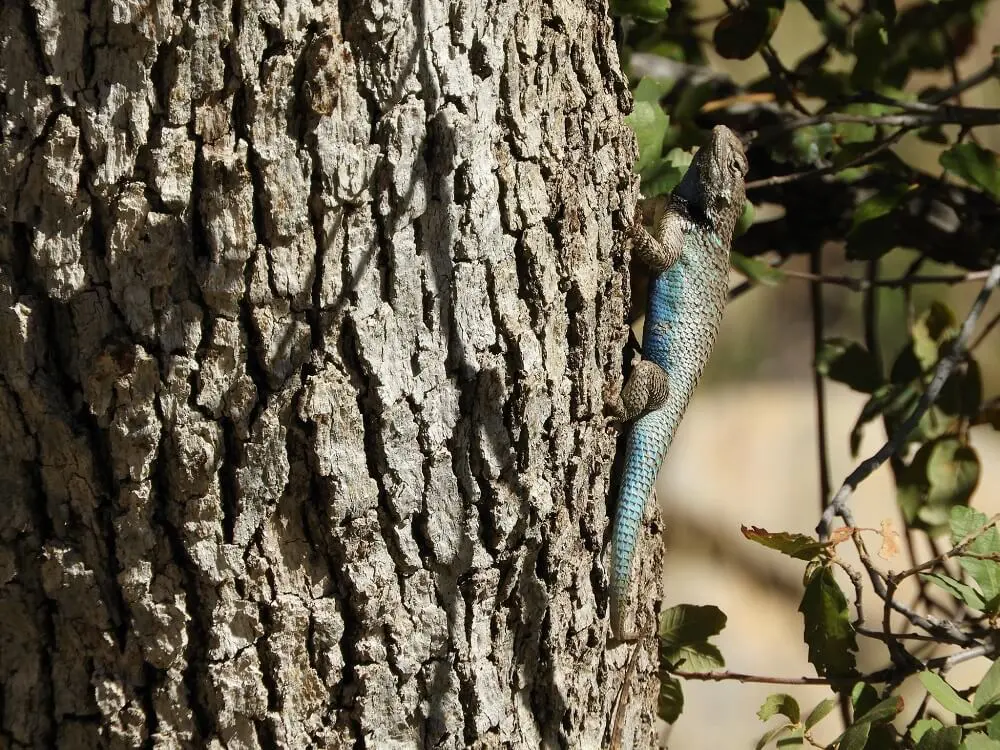
Scientific name: Sceloporus clarkii.
Common name: Clark’s spiny lizard.
Clark’s spiny lizard is a medium to large reptile that grows up to 5.25 inches (12.8cm) in length from snout to vent.
They have pointed scales with a gray, blue, or tan base with a purple stripe that goes down their back with single yellow scales on the sides.
They have a dark band around their necks with males showcasing a blue dewlap and tummy.
Females have red to orange heads during mating season.
These lizards prefer semi-arid and arid regions, along with mountain slopes. They are often found in rocks and sometimes even in trees, they can be found under boulders.
Further Reading: What lizards with red or orange heads?
10. Gila Monster

Scientific name: Heloderma suspectum.
Common name: Gila monster.
The Gila monster is the only poisonous lizard you will come across in Arizona.
It is a slow-moving lizard that can grow up to two feet (60cm) in length.
While it is venomous, it’s not fast, therefore it is not a real threat to humans and it is a protected species in the state of Arizona.
Their head, back, and tail scales have pearl-shaped bones.
Adults are black with yellow to pink coloration. Males have large triangular heads when comprising them to females.
These lizards prefer the succulent desert, woodlands, and scrublands. They are often found hiding in burrows or under rocks. They need water and are often seek soaking in puddles after the rains.
Their venom is considered as toxic of the Western diamondback rattlesnake with symptoms ranging from agonizing pain to weakness and edema.
A bite is usually not fatal to a healthy human. If bitten, ensure you seek immediate medical treatment.
11. Greater Earless Lizard
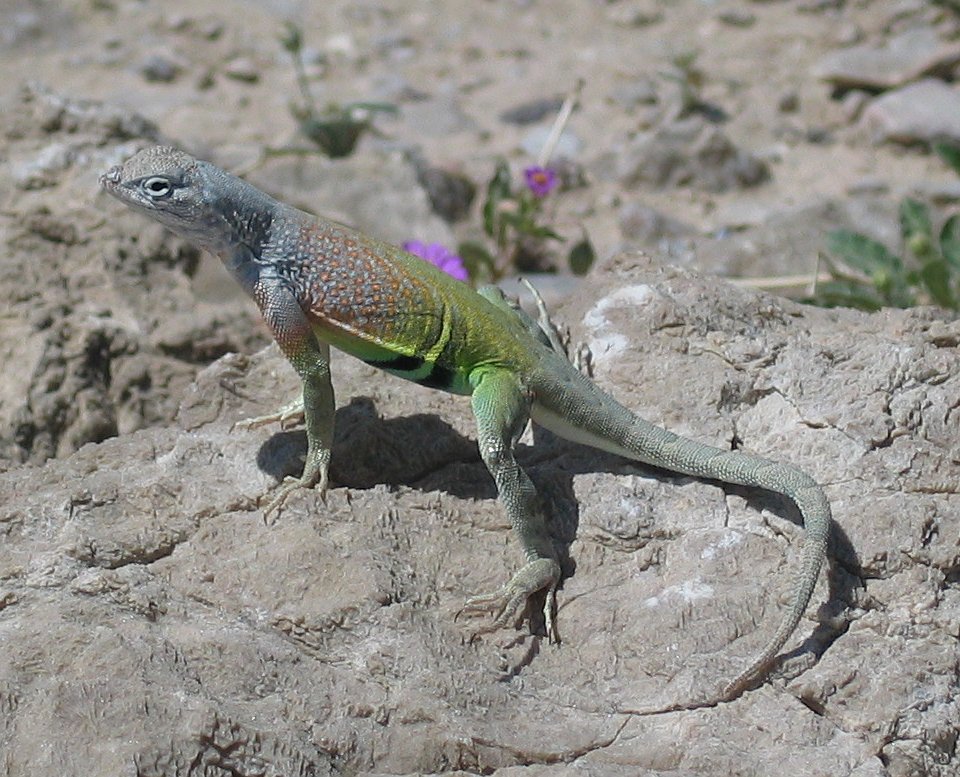
Scientific name: Cophosaurus texanus.
Common name: Greater earless lizard.
These earless lizards can grow up to seven inches (18cm) in length with males being bigger than the female.
Males have two black stripes in front of their hind legs, while females have a black stripe behind each thigh.
They have two throat folds and large eyes.
While their ears do not have an external opening, they can hear.
These lizards are active in the day, hibernate in winter, and will wag their tails to distract predators if approached, along with push-ups, head bobbing, and body compression.
They have an interesting defense mechanism with an opening on the top of the head, called a blood sinus, which gains excellent heat during the day. The blood can be channeled to the eyes when predators approach, enabling them to spray blood on the predator, therefore allowing them to escape.
12. Western Banded Gecko

Scientific name: Coleonyx variegatus.
Common name: Western banded gecko.
The Western banded gecko can grow up to six inches (15cm) in total length. They have a sandy-colored body with dark cross bands and tiny scales. They have movable eyelids.
They live in a variety of habitats including deserts, woodlands, and long grass.
They are nocturnal, which means they are active at night, yet they are very secretive as they hunt for small spiders and insects.
If captured it will break its tail.
They are also known to pull their tail up over their bodies, making them look like a scorpion to distract predators.
13. Regal Horned Lizard

Scientific name: Phrynosoma solare.
Common name: Regal horned lizard.
This is a flat, small lizard that can fit on the palm of your hind.
It has spikes around its entire body with its regal horn being the main defense, along with squirting blood out of its eyes.
Adults can grow up to four inches (11cm) from snout to vent.
They are yellow/brown or gray in color with red blotches on the body.
They are slow and therefore use their camouflage to get away from predators.
These lizards are common in southeastern Arizona, especially along the central mountainous region. They prefer gently sloping to level terrain with sparse vegetation. They are found in hot and dry climates.
14. Sonoran Spotted Whiptail

Scientific name: Aspidoscelis sonorae.
Common name: Sonoran spotted whiptail.
The Sonoran spotted whiptail is a medium-sized lizard that grows up to 3.5 inches from snout to vent and up to 12 inches in total length.
They have a pointed spout and thin body that is black to brown in coloration with six yellow stripes.
These lizards can be found in grasslands, woodlands, desert shrubs, and more.
15. Common Chuckwalla

Scientific name: Sauromalus ater.
Common name: Common chuckwalla.
This is a large lizard with a flat body and rounded tummy and blunt-tipped tail.
They can grow up to 20 inches in total length and weigh up to 9kg.
They have small scales that cover the body with larger scales that are responsible for the protection of its ear openings.
Adult males tend to have black on their head, pelvic region, and shoulders, with a light tan mid-body with brown speckles.
Adult females are brown with dark red spots, while juveniles have four to five broad bands on their bodies with three to four bands on their tails, which fade as they age.
They hide from any potential predators, running between a rock crevice, inflating their lungs to hold themselves in place.
These ground-dwelling lizards will spend most of their morning soaking up the sun.
16. Mediterranean House Gecko

Scientific name: Hemidactylus turcicus.
Common name: Mediterranean house gecko.
This gecko is a house gecko common to Mediterranean areas, which has now spread throughout the world.
They are small in size, reaching up to 5.9 inches (15cm) with large eyes without eyelids and tan skin with black spots.
They often do have stripes on their tails. They have translucent tummies. They have a rounded snout, concave forehead, and ear openings with a moderate-sized body and limbs.
They have a cylindrical, but depressed tail that tapers at the end.
Often, they are translucent with only their spots visible, while others appear darker.
They seek darkness when fleeing from predators.
17. Eastern Collared Lizard

Scientific name: Crotaphytus collaris.
Common name: common collared lizard, eastern collared lizard, Oklahoma collared lizard, yellow-headed collared lizard, collared lizard.
This lizard is easily identified by its two black bands around the neck.
Adults have green scales combined with yellow, blue, brown, and olive scales. Females are dull in color. Both males and females have large heads and white tummies.
These lizards are able to run on their back legs and have a large stride, which is more than three times the length of their bodies.
They do not break their tails as easily as other lizards and in the event, they do have to break their tails, it will not regrow.
The Eastern collard lizard (Crotaphytus collaris) lives in a host of habitats from grasslands and desert shrubs to sagebrush. They do prefer rocky areas.
18. Arizona Alligator Lizard

Scientific name: Elgaria kingii.
Common name: Arizona alligator lizard.
The Arizona alligator lizard is a large 5.5 inch lizard with a long body and small limbs, with a long and thick tail.
They have stiff armored scales. They are tan to gray in color with a red or chocolate cross band with dark edges.
You find these lizards in foothills, on mountain slopes, and in low valleys.
They are active during the day and are often seen looking for prey in leaf litter and in rock piles.
19. Desert Grassland Whiptail

Scientific name: Aspidoscelis uniparens.
Common name: Desert grassland whiptail lizard.
The desert grassland whiptail grows to only 5.25 inches (13cm) in length. They are slim with a thin tail that is considerably longer than the body.
They have six yellow lines that run down their body, the body is brown or olive in color that fades to blue or gray on the tail. Juveniles have bright blue tails, which fade as they age.
These lizards can be found in the desert areas of southern to central Arizona. They prefer low valleys, slight slopes, and grasslands.
20. Desert Iguana

Scientific name: Dipsosaurus dorsalis.
Common name: Desert iguana.
The desert iguana grows up to sixteen inches (41cm) in total length and is gray to tan in color with light brown patterns on their sides and backs.
Their tails are one and a half times longer than the body.
These lizards prefer dry and sandy habitats but are often found on rocky streambeds.
They can withstand high temperatures and can be seen, even when other lizards have gone into hiding to escape the head.
They do burrow if threatened, with the burrow being dug under bushes.
21. Great Basin Collared Lizard

Scientific name: Crotaphytus bicinctores.
Common name: Great Basin collared lizard, desert collared lizard, the Mojave black-collared lizard.
The great basin collared lizard has a large head and hind legs with two black bands on the neck.
Males have a larger head than the female, along with a dark throat and brighter orange crossbands across the body. Sizes can range from 2.5 inches to 4.5 inches from snout to vent.
They have a thick tail that is double the length of the body.
22. Sonoran Collared Lizard

Scientific name: Crotaphytus nebrius.
Common name: Sonoran collared lizard.
The Sonoran collared lizard is endemic to Arizona and Sonora in Mexico.
These lizards are gray to yellow in color with grey/white spots. The spots are small on the sides and get larger down the center of the back.
These lizards are mostly active during the spring and summer months.
23. Long-nosed Leopard Lizard

Scientific name: Gambelia wislizenii.
Common name: Long-nosed leopard lizard.
The long-nosed leopard lizard can be cream, white or gray with brown or dark gray spots on their heads and body. Some have dark bars on their backs and on their tails.
Some juveniles will have rust coloring and bright red spots with yellow under their tails and on their thighs.
Females can grow to 5.8 inches, with males being smaller, growing to around 4.8 inches, excluding the tail.
They are able to change color and their spots disappear in their dark phase, light phase and the lizard can have yellow, pink, gray, or brown hues.
24. Spiny-tailed Iguana

Scientific name: Ctenosaura spp..
Common name: Spiny-tailed iguanas.
The spiny-tailed iguana is gray to brown in color with black coloring when they are younger.
They are the only species of the spiny tail iguanas that are so dark when they are juveniles. As they age, they can be a light gray or blue color, based on the heat conditions at the time.
Males grow to 30 inches and females around 22 inches, including their tails.
25. Lesser Earless Lizard
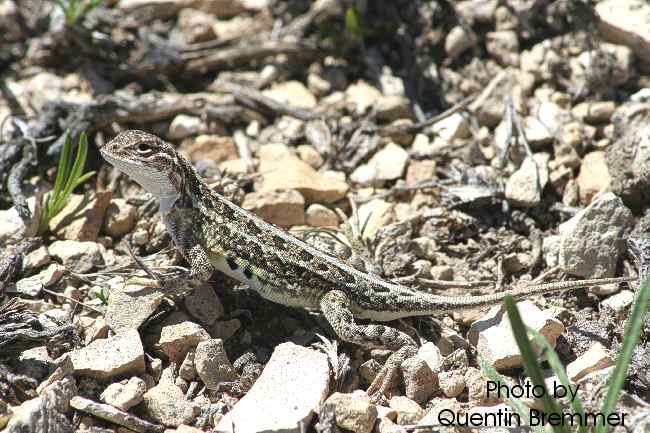
Scientific name: Holbrookia maculata.
Common name: Lesser earless lizard.
The lesser earless lizards are endemic to the central and southwestern parts of the United States and Mexico.
There are nine subspecies of the lesser earless lizard, which includes the Mexican earless lizard, speckled earless lizard, northern earless lizard, and more.
26. Elegant Earless Lizard

Scientific name: Holbrookia elegans.
Common name: Elegant earless lizard.
This is a small lizard that is native to Mexico and the United States. They grow to around 3 inches in length and are tan or gray in color. Their tails are longer than their body length.
27. Texas Horned Lizard

Scientific name: Phrynosoma cornutum.
Common name: Texas horned lizard, horny toad.
This is the largest and most widely distributed horned lizard in the Western United States, out of all fourteen species.
The Texas horned lizards grow to around 2.7 inches from snout to vent. Males can grow up to 3.7 inches and females to 4.5 inches when you include their tails.
They are very docile lizards but puff themselves up, causing their body scales to protrude when they feel threatened. This makes them hard to swallow.
They are also able to squirt blood from their eyes, which confuses their predators and is foul-tasting.
28. Sonoran horned lizard
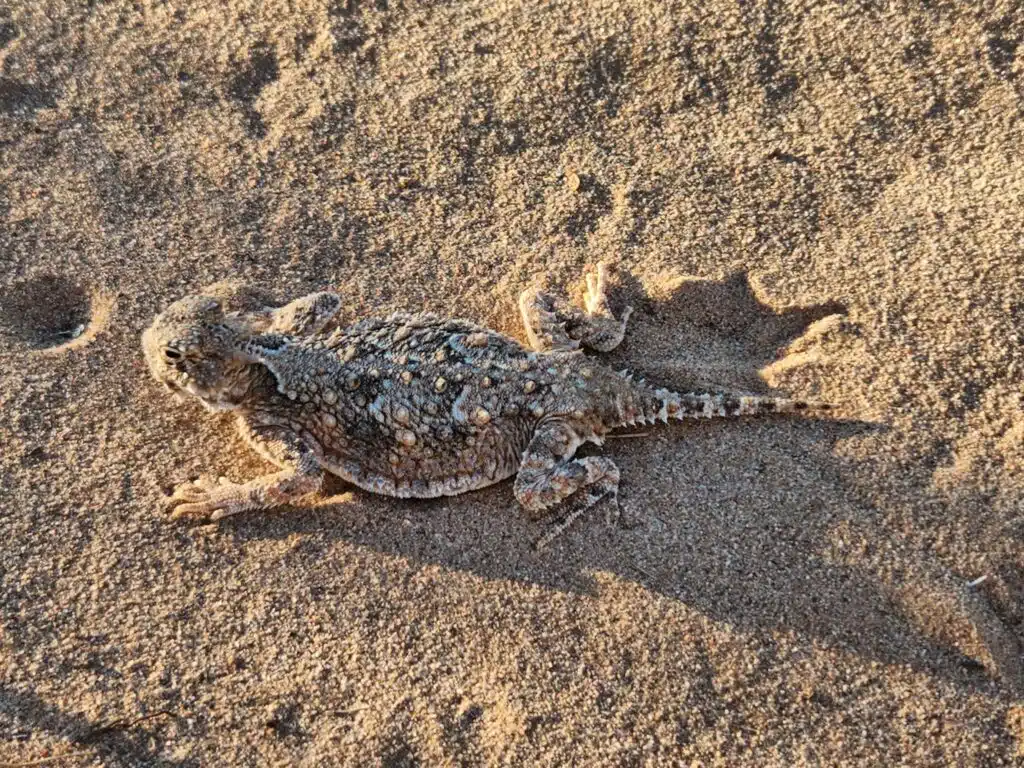
Scientific name: Phrynosoma goodei.
Common name: Sonoran horned lizard.
These medium-sized lizards grow to 9cm from snout to vent, excluding the tail.
They have three temporal horns on either side of their heads and two elongated horns that point upwards and to the back.
Their color matches the local substrate, ranging from orange to gray. They usually have two rows of dark spots on either side of the dorsal line, but they can be very faint.
They have a banded tail, though some species have no pattern.
29. Flat-tailed Horned Lizard

Scientific name: Phrynosoma mcallii.
Common name: Flat-tailed horned lizard.
The flat-tailed horned lizards are a medium-sized lizard that lives in a small area of the Sonoran Desert in southwestern Arizona.
They have an oval-shaped body with pointed scales on the tail and upper body.
They have smooth skin on their backs with small spines and eight horns which extend from the back of their heads.
The flat-tailed horned lizard is able to conceal its shadow in the desert, when out in the open.
30. Round-tailed Horned Lizard
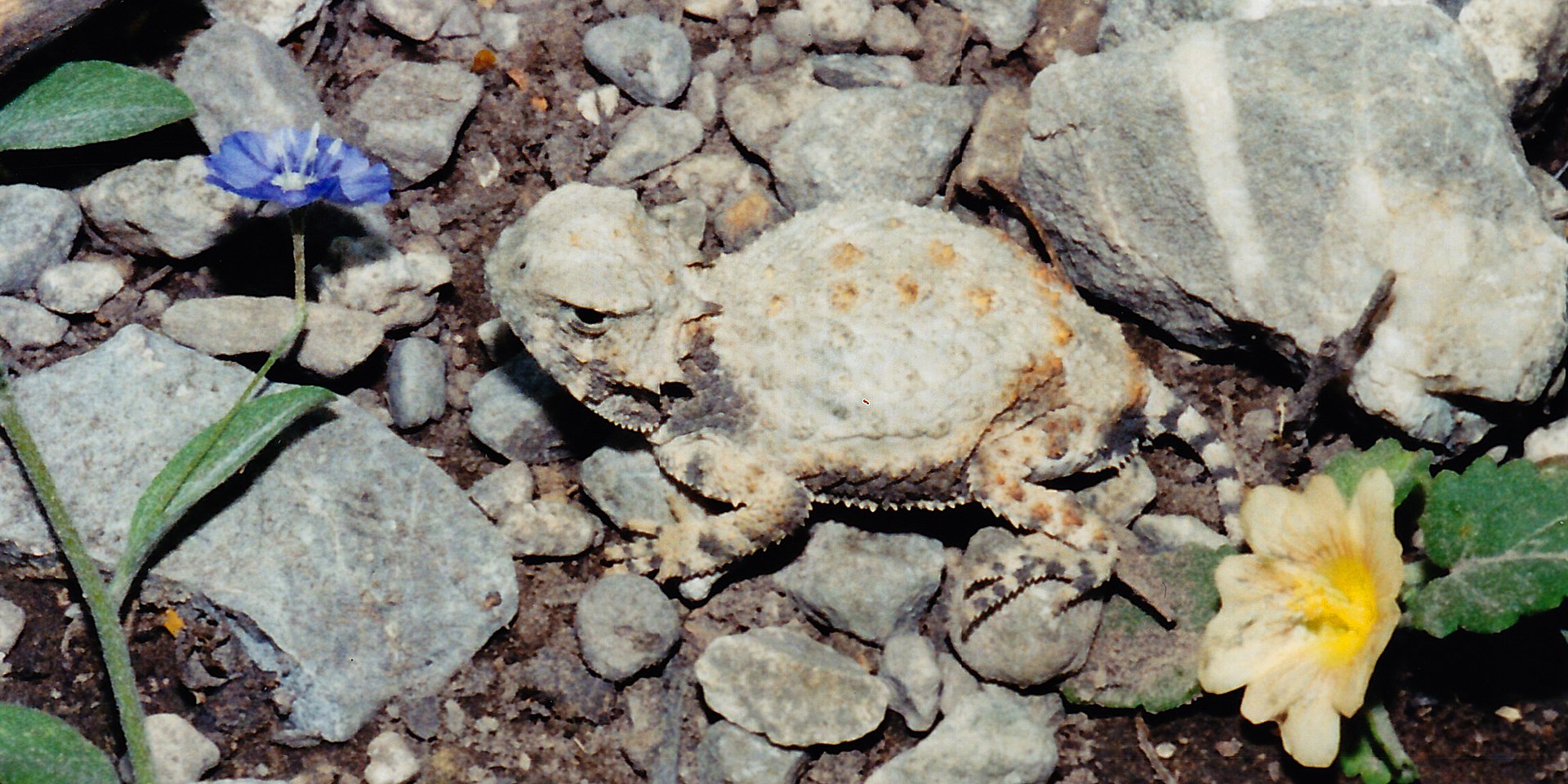
Scientific name: Phrynosoma modestum.
Common name: Round-tailed horned lizard.
The round tailed horned lizard lives in semi-arid habitats with very sparse vegetation, where they live on a diet of harvester and honeypot ants.
These lizards blend into the color of their habitat and are usually gray in color, though they can be pale yellow or light brown. The neck and groin have darker coloring, some have some stripes on their tails.
The round-tailed horned lizards grow to 4.3 inches (10.5cm) in total length, including the tail.
31. Desert Horned Lizard

Scientific name: Phrynosoma platyrhinos.
Common name: Desert horned lizard.
The desert horned lizard can be distinguished from other horned lizards with its flat body and one row of fringe scales that are on the sides.
This is a medium-sized lizard that grows to 9.5cm (3.75 inches) in total length.
Their colors range from red/brown to tan or beige, depending on the color of the surrounding soil. They have prominent dark patches on the neck, which are bordered by gray or light white.
32. Twin-spotted Spiny Lizard

Scientific name: Sceloporus bimaculosus.
Common name: Twin-spotted spiny lizard.
This is a large 12.1cm spiny lizard. Its tail is more than double the length of the body.
They have a row of dark spots on both sides of the mid-dorsal line. Males have blue on their chin and throat and on their belly. Females and juveniles do not have blue throat or belly patches.
33. Southwestern Fence Lizard

Scientific name: Sceloporus cowlesi.
Common name: Southwestern fence lizard, Cowles’ prairie lizard, White Sands prairie lizard, the White Sands swift.
The Southwestern fence lizard is a spiny lizard species originally described in 1956. They are native to the Chihuahuan Desert. They are a subspecies of the eastern fence lizard.
34. Sagebrush Lizard

Scientific name: Sceloporus graciosus.
Common name: Sagebrush lizard.
The sagebrush lizard grows to 3.5 inches (8.9cm) from snout to vent.
They look similar to the Western fence lizard, though they are smaller.
The sagebrush lizard is olive, brown, or gray with green or blue on the surface when they are in the light phase. Males have blue patches on their belly and throat, which female sand juveniles do not have. Males have orange coloration during mating season.
They prefer forests and woodlands where they can bask on rocky outcrops and logs to soak up the sun.
35. Slevin’s Bunchgrass Lizard

Scientific name: Sceloporus slevini.
Common name: Slevin’s bunchgrass lizard.
The Slevin’s bunchgrass lizard is named after Joseph R Slevin, who was a holotype specimen collector and was first described in 1937. They are found in Southeastern Arizona where they prefer grassland and forest areas.
Adults grow to 2.8 inches (7cm) without their tails.
36. Yellow-backed Spiny Lizard

Scientific name: Sceloporus uniformis.
Common name: Yellow-backed spiny lizard.
Yellow-backed spiny lizards are large lizards with adults growing to 5.5 inches, excluding their tails. Their tails are longer than their bodies.
The body is tan or brown with black and yellow stripes and a black collar on the neck.
Males are larger than females with blue markings on the belly and throat.
37. Striped Plateau Lizard

Scientific name: Sceloporus virgatus.
Common name: Striped plateau lizard.
The striped plateau lizard belongs to the North American spiny lizard family and can grow up to 4.8cm. They are ground dwellers and move quickly across the ground if startled.
38. Yuman Fringe-toed Lizard

Scientific name: Uma rufopunctata.
Common name: Yuman fringe-toed lizard.
The Yuman fringe-toed lizard lives in a limited area in the southwestern United States and northwestern Mexico. They live south of the Gila River, mostly in the Yuma and Mohawk dune systems.
39. Mohave Fringe-toed lizard

Scientific name: Uma scoparia.
Common name: Mojave fringe-toed lizard.
This is a smooth-skinned, flat bodies lizard that can range from tan brown to gray-white with black spots on its back. Their skin helps them blend into their environment.
They have dark banding on their tails and dark patches on the side of their belly. The dark spots turn to pink and their belly turns yellow during mating season.
Their body and tail are of equal lengths with a total length of around seven inches.
40. Long-tailed Brush Lizard

Scientific name: Urosaurus graciosus.
Common name: Long-tailed brush lizard.
The long-tailed brush lizard comes from the Sonoran Desert in Arizona, California, and Nevada. They also occur in the Mojave Desert, along with Mexican states.
These lizards have tails which are more than double the length of the body.
They are excellent climbers and will camouflage against branches and hide in wait for passing insects.
Further Reading:
41. Mountain Skink
Scientific name: Plestiodon callicephalus.
Common name: Mountain skink.
This medium-sized skink can grow to three inches (7.5cm) without its tail.
They are brown to olive in color with black stripes on their sides. Juveniles have bright blue tails, which fade slightly as they age, but they do retain some of the blues in adulthood.
They live in a variety of habitats where they can be found hiding under leaf litter.
42. Gilbert’s Skink

Scientific name: Plestiodon gilbert.
Common name: Gilbert’s skink.
The Gilbert’s skink can be found in western Arizona and prefers a habitat of grassland, pine forests. They do not enjoy densely forested areas.
This skink has a heavy body with small legs.
Adults are gray, brown, green, or olive, while juveniles will have lighter stripes on their sides that enclose a large dark stripe. The stripes fade as they age.
43. Many-lined Skink

Scientific name: Plestiodon multivirgatus.
Common name: many-lined skink, northern many-lined skink, variable skink.
The many-lined skink grows to around 12 inches (19cm) in total length, including the tail.
They have brown to olive-colored bodies and are medium in size. Their black stripes are seen on the tail and body.
They enjoy rocky habitats.
44. Great Plains Skink

Scientific name: Plestiodon obsoletus.
Common name: Great Plains skink.
This is a large skink that grows to 14cm without its tail.
They are gold, green/gray, or yellow in color with a net-like pattern.
They have shiny scales and their tails tend to be more than one and a half times the length of their bodies.
Males have a broader head than the female.
Hatchlings are black with dark blue tails; their coloration lightens as they age.
45. Western Skink

Scientific name: Plestiodon skiltonianus.
Common name: Western skink.
The western skink can be found in a range of habitats, though they prefer open areas that are moist, though they are often seen on dry hillsides.
These lizards prefer woodlands, open pine forests, and grasslands with moist sand.
They have a black to brown band that starts on the side of the head and goes beyond the hind legs, the band is bordered with a white to beige stripe.
46. Arizona Striped Whiptail

Scientific name: Aspidoscelis arizonae.
Common name: Arizona striped whiptail.
The Arizona striped whiptail is endemic to the United States, where it lives in the grassy desert areas in Arizona, often found in desert shrubs.
They grow to 2.8 inches in length with long tails, which resemble a whip.
They are very fast runners and will bolt and hide if approached or feel threatened.
They have brown and blue bodies with yellow stripes, which helps tell them apart from the Pai striped whiptail.
47. Canyon Spotted Whiptail

Scientific name: Aspidoscelis burti.
Common name: Canyon spotted whiptail.
The Canyon spotted whiptail is found in Arizona and Mexico.
They are tan in color with white stripes and spots on their bodies.
These are very shy lizards and are excellent at hiding, therefore there are not many observations in Arizona.
48. Chihuahuan Spotted Whiptail

Scientific name: Aspidoscelis exsanguis.
Common name: Chihuahuan spotted whiptail.
This is a medium-sized lizard that is striped and spotted. It can grow up to 10.7cm without the tail. This is an all-female species.
They are light stripes that fade as they age, but you will see the stripes on their necks.
48. Gila Spotted Whiptail

Scientific name: Aspidoscelis flagellicauda.
Common name: Gila spotted whiptail.
The Gila spotted whiptail is a Sonoran lizard found in Arizona and New Mexico in the United States. It is also found in Mexico. They are shy and will run fast to escape threats.
50. New Mexico Whiptail

Scientific name: Aspidoscelis neomexicana.
Common name: New Mexico whiptail.
This whiptail can grow to 9.1 inches (23cm) in total length.
They are brown to black in color with seven pale yellow stripes and light-colored spots that can be found between the stripes. Their bellies are white or pale blue with blue or blue/green throats.
The New Mexico Whiptail has a slender body and a long tail.
They are very wary and fast and will dart for cover if approached.
51. Pai Striped Whiptail

Scientific name: Aspidoscelis pai.
Common name: Pai striped whiptail.
The Pai striped whiptail is often confused with the Arizona striped whiptail. They belong to the Aspidoscelis genus and are endemic to Arizona.
52. Plateau Striped Whiptail

Scientific name: Aspidoscelis velox.
Common name: Plateau striped whiptail.
The Plateau striped whiptail belongs to the quamata species in the New World runner’s family. They are ground dwellers that are wary and fast and will run away if approached.
53. Red-backed Whiptail

Scientific name: Aspidoscelis xanthonota.
Common name: Red-backed whiptail.
The red-backed whiptail is an attractive whiptail lizard that comes from a limited range in the United States, including south-central Arizona.
They are not often observed, so seeing one of these lizards is a real treat.
54. Arizona Night Lizard

Scientific name: Xantusia arizonae.
Common name: Arizona night lizard.
The Arizona night lizard grows to around 10cm in length. They have dark spots on their sides, large eyes, and prefer a secluded lifestyle.
They are mostly active in the summer and spring. They are secretive and not often observed.
55. Bezy’s Night Lizard

Scientific name: Xantusia bezyi.
Common name: Bezy’s night lizard.
The Bezy’s night lizard is a small and smooth-skinned lizard that is yellow/brown or gray/brown in color, measuring up to 7cm without the tail.
They have flat heads and dark patches on the back.
They prefer pine woodlands and desert highlands, where they hide under rocks.
56. Desert Night Lizard

Scientific name: Xantusia vigilis.
Common name: Desert night lizard.
This lizard grows up to 7cm (2.75 inches) in body length, with a tail that is around the same length of the body.
They are yellow/brown, olive, or gray in color. They are able to change their color from light olive to dark brown, helping them soak up the sun easily.
They are excellent climbers eating a range of insects. They are very secretive and prefer semi-arid areas.
57. Giant Spotted Whiptail

Scientific name: Aspidoscelis stictogrammus.
Common name: Giant spotted whiptail.
The giant spotted whiptail can be found in Arizona and is a large whiptail growing to 51cm including its tail.
They have a pointed head, elongated body, and tail.
58. Keeled Rock Gecko

Scientific name: Cyrtopodion scabrum.
Common name: rough-tailed gecko, rough bent-toed gecko, rough-tailed bowfoot gecko, common tuberculate ground gecko, keeled gecko.
The keeled rock gecko is also known as the rough-tailed gecko and is endemic to Asia. It has been introduced in many countries, including Arizona and Texas, in the United States.
Further Reading:
59. Little Striped Whiptail

Scientific name: Aspidoscelis inornatus.
Common name: Little striped whiptail.
The little striped whiptail grows to 9.5 inches and is black in color with white or yellow striping from the head to tail. They also have blue on their belly.
They are slender in shape with a blue tail that is more than double the length of their body.
Males have more blue coloration than the female and stripes are not always noticeable.
They are very fast and wary and will dart for cover if they feel threatened.
60. Mohawk Dunes Fringe-toed Lizard

Scientific name: Uma thurmanae.
Common name: Mohawk dunes fringe-toed lizard.
The Mohawk dunes fringe-toed lizard is tan to brown in color, which helps them blend into their surroundings, hiding from predators.
They have fringes on the sides of their toes, helping them with traction when moving through the loose sand dunes.
They can be found in southwest Arizona in low desert areas with fine and loose sand.
Further Reading: